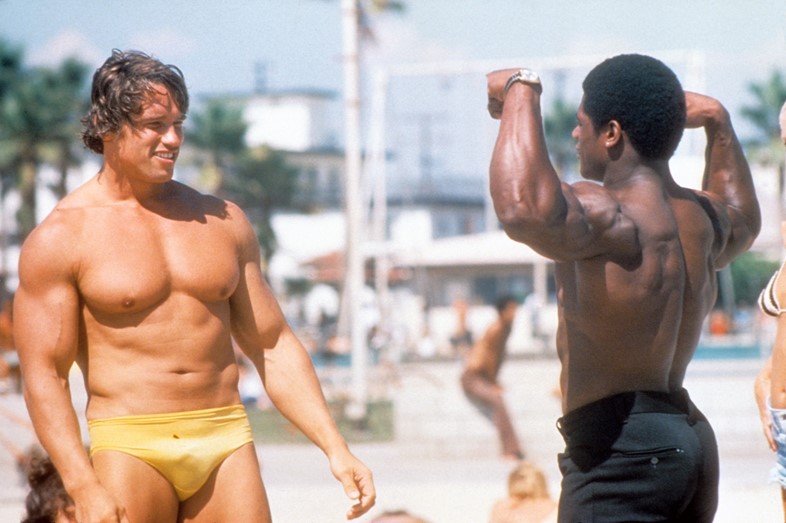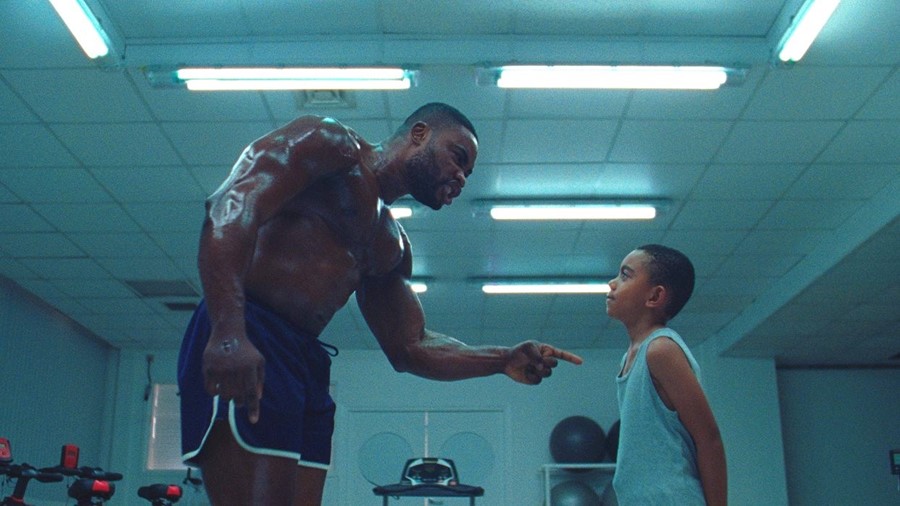Defined as a preoccupation with one’s perceived lack of muscularity, muscle dysmorphia is becoming increasingly prevalent, causing what experts are calling a ‘silent crisis’ in men’s mental health
Like many boys in the 90s, Jonathon Freelove played with action figures. He-Man, Ninja Turtles and ThunderCats were his favourites. While the characters were imaginary, he knew one part of them resembled the human world: their torsos. Swollen biceps and defined abdominal muscles on the plastic figurines were his first introduction to what masculinity and the male physique could look like.
By adolescence, the seemingly flawless, God-like Arnold Schwarzenegger and Rocky Balboa were his idols. He would pick up his father’s copies of Men’s Health around the house and flick through. It was 2001, and headlines included: “Fat to Flat”, “Sex. Money. Muscle.”, and “Look Great Naked”.
Determined to resemble the jacked-up bodies he’d aspired to since childhood, Freelove started lifting weights, and replaced “bad” food with “clean” alternatives. Although his new hobby was praised by those around him, “it was just a form of self-harm, because I hated the way I looked,” he says. As his body goals became increasingly unattainable, the habit became an obsession; the more he burned, the further his confidence fell. Within a year of lifting weights, Freelove was admitted to The Priory Hospital in Birmingham for a nine-month-stay, for an eating disorder.
“My ankle was swollen up because I had severe fluid retention, and I was having irregular heartbeats,” he says, a consequence of abusing caffeinated pre-workout powders. But in treatment, one thing baffled him – he was trying to get bigger, not smaller. “I was obsessed with muscularity,” he says. He then received an additional diagnosis: muscle dysmorphia (MD).
“The day you start lifting is the day you become forever small,” is a common phrase in the bodybuilding community. While for many bodybuilders this mantra speaks to their drive for ever-bigger muscles that characterises the sport, for a smaller section of the population, it encapsulates the losing battle that is MD.
WHAT IS MUSCLE DYSMORPHIA DISORDER?
MD is a subtype of body dysmorphic disorder (BDD) which affects two percent of the population. Seen mostly in men, it’s defined as a preoccupation with one’s perceived lack of muscularity, despite having an average build, or in many cases, an extremely muscular body. This results in repeated behaviours to try to fix the perceived flaw: abusing pre-workout supplements, steroids, excessive exercise, restrictive eating and body checking.
The condition is not classified as an eating disorder, however, symptoms often occur concurrently. It entered the psychiatric lexicon in 1997, and in 2002, The Adonis Complex: How to Identify, Treat and Prevent Body Obsession in Men and Boys was published, which introduced the novel idea that a gym obsession could become pathological, decades before the fitness industry would find its most profitable frontier on social media.
But it’s important to distinguish between avid gym-goers with insecurities and clinical dysmorphia. A key sign is when the fixation begins to interfere with one’s daily activities, says Viren Swami, professor of social psychology at Anglia Ruskin University. For instance, when George Mycock, 27, from Stoke-on-Trent, spent a day or two off his diet, or out of the gym, he’d be consumed by paranoia that everyone would know. So, he’d avoid leaving the house, he says, and at rock bottom, he locked himself away for three weeks. He’d planned to take his own life, but was narrowly saved by a friend.
WHY CASES OF MUSCLE DYSMORPHIA ARE RISING
While the first recorded cases were over two decades ago, body image concerns are becoming increasingly prevalent among young males. “It has seemed to explode over recent years,” says Dr Gabriela Vargas, director of the Young Men’s Health website at Boston Children’s Hospital. Love Island torsos, algorithm-fueled protein shakes and YouTube videos with titles such as “The Secret of How Andrew Tate Got HUGE While in Prison,” are pressuring boys and men to bulk up. “I've struggled with it because of how normalised [the gym] has been,” Freelove says. “When really, for me, it’s the place I shouldn’t be going.”
Over half of British men show signs of body dysmorphia, a recent report found. Within the community of avid male gym-goers, a study published last year in the US found that all participants who immersed themselves in bodybuilding practices described themselves as having some degree of muscle dysmorphia.
Men, however, are less likely to seek treatment than women – despite one in three eating disorders occurring in men, according to the National Eating Disorder Association, only one in 20 people in treatment are male, Vargas says. Meanwhile, in 2016, it was reported that less than one percent of all the body image and eating disorder research was conducted exclusively on males, leading some researchers to state that this is a “silent crisis” in men’s mental health.
“We’re still learning a lot about it, because in part, it just hasn’t been prioritised in research,” Vargas says, of MD. “There is this huge shift that needs to happen in terms of acknowledging that this is a significant concern for men,” she says.

A PERVASIVE CULTURE OF STEROIDS
Freelove overcame his eating disorder in hospital, but he continues to struggle with dysmorphia. At his lowest, he would visit the gym multiple times daily and abuse SARMs, illegal muscle-enhancing drugs that mimic the effects of testosterone and anabolic steroids, that have been found to be sold in UK shops. He learnt about them via YouTube influencers, who trivialised the strawberry and watermelon drinks as gym bag must-haves. But upon a visit to the doctor for depression – that he would later learn was at least partially SARMs-inflicted – he was told he had the testosterone levels of a 90-year-old man. He still takes hormone replacement medication to reverse the damage.
There are still more than one million, predominantly male, steroid users in the UK, according to the UK Anti-Doping agency. Research from marketing firm Mintel found almost a quarter of men aged 16-24 in the UK take supplements for exercise. “We know that teens that are using protein supplements are moving on to the anabolic steroids,” says Vargas, because immersing into the gym community can increase the risk.
On the more extreme end, bodybuilders have even died in recent years from suspected steroid-related causes, including celebrity bodybuilder Rich Piana at the age of 46. Piana freely admitted having taken steroids since he was a teenager, however, the cause of his death so far remains unclear.
“If you want to win your class and try to be a professional bodybuilder, you have to take steroids,” says bodybuilder Grant Lloyd, 25, from North Carolina, who uses the drugs. He began taking part in competitions at age 14, and suffers from MD, but thinks that the sport’s endemic steroid culture makes it unavoidable.
@delt.daddy Reply to @batshit84 #greenscreen sarms without a pct? #fyp #fypシ #bodybuilding #aesthetic ♬ original sound - Makaia Childress
UNREALISTIC BODY IDEALS ON SOCIAL MEDIA
Due to the competitive and aesthetic nature of bodybuilding, social media is a natural home for the culture. Oscar*, 27, an online trainer and non-competitive bodybuilder from Liverpool who asked to remain anonymous, started sharing content on Instagram. “I would get one negative comment like, ‘oh, why are you giving advice on muscle growth? You’re so small,’” he says, leading him to experience dysmorphic thoughts. Now, to acknowledge his growth, he must compare side-by-side past and present pictures of himself. Otherwise, in his reflection, he simply feels too small, he says.
And following bodybuilders only worsened this. “Social media shows you the one per cent of people who look the best of the best, whose content performs the best – it creates this echo chamber,” he says, especially due to the prevalence of steroid usage.
Greater social media usage among adolescent and young adults has been associated with symptoms of muscle dysmorphia, according to a study published this year. It described social media algorithms as “rabbit holes,” that “ultimately perpetuate the unrealistic body ideals, which are commonly posted on social media and precipitate attempts to change one’s body.”
TOXIC MASCULINITY
But the rise in MD runs deeper than algorithms. Mycock believes that for some, the appeal of building muscle is being “able, capable to fight, intimidating, dominant – these patriarchal ideas of what a man should be.” And Freelove admits he partially got into weightlifting to appear attractive to women: “If I look like this, I’ll be able to get in a relationship”.
Swami sees this intertwining of muscularity and masculinity as a relatively recent cultural change, beginning in the early 90s, when fashion and beauty industries realised the market power of targeting men, he says. Men began to be sold the idea that their bodies are non-biological commodities to be invested in, he says. And with the backdrop of evolving gender roles, Swami thinks muscle-building offers immediate agency over one’s virility: “It’s the one form of masculinity that feels like it’s malleable.”
But for Oscar*, as a transgender man, this malleability was a lifeline: while on a two-year wait list for hormone therapy, he started weightlifting to connect with his masculinity.“I thought, well, if I build more muscle, I know I can look closer to how I feel in my head,” he says.
But living within a culture that valorises the muscular physique can delay recovery, MD sufferers say. “A lot of your physical symptoms to the outward world are great,” says Mycock. As a result, self-destructive behaviours can be hidden in plain sight. “It’s hard to stomach the nuance of it because for so long, we’ve been told it’s good – and no matter what, it’s good,” he says. He adds: “Exercise should be treated more like medicine, in the sense, there’s always a list of side effects.”
Join Dazed Club and be part of our world! You get exclusive access to events, parties, festivals and our editors, as well as a free subscription to Dazed for a year. Join for £5/month today.




